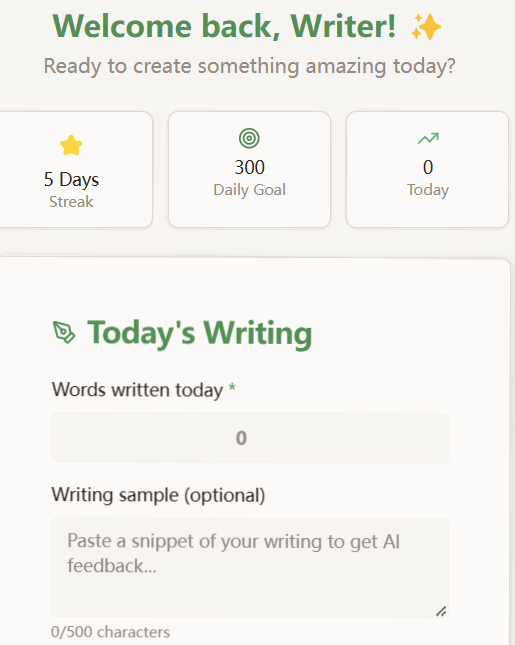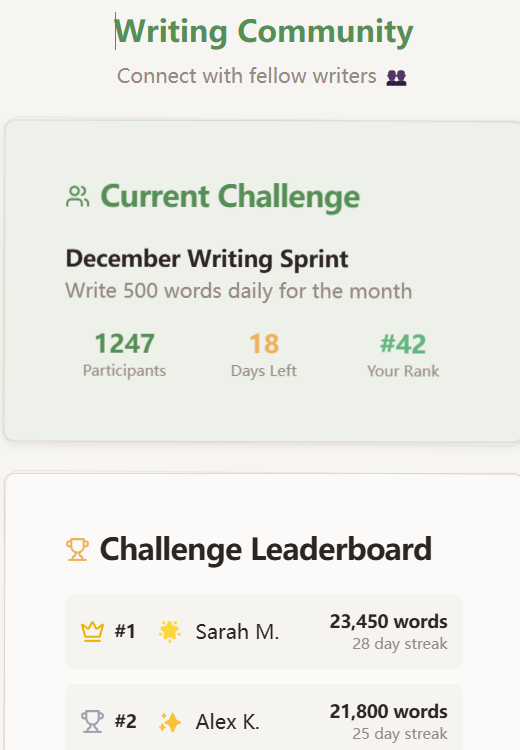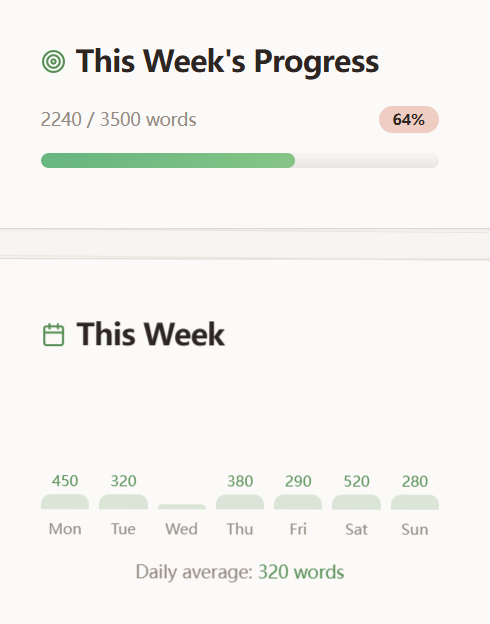How US Writers Build Daily Writing Habits (2025 Guide)
Discover how US-based writers build daily writing habits in 2025 — including key trends, tools, and insights from the booming writing habit app space.
Introduction
If you're a writer, student, or content creator living in the United States, you know the drill: you want to write every day, but somehow the schedule, distractions, or lack of accountability get in the way.
In 2025, finishing a draft isn't the main win anymore—showing up consistently is. And that's where writing habit apps step in: helping you turn writing from "someday" into "today".
In this guide we'll walk through:
- The challenges US writers face when trying to build a daily writing habit.
- Why a writing habit tracker app matters more than ever in 2025 for US-based creatives.
- What the US market looks like for these tools.
- Must-have features in a writing habit tracker.
- How to pick the right tool (depending on whether you're a student, freelancer, or blogger).
- A real-life routine example of a US writer using a habit tracker.
- Final take-aways and a gentle invite to explore one option: Writick.
Let's get started.
US Writers' Challenge: Why Habit Is Hard to Build
Writing is more than sitting at a keyboard. In the US, writers are juggling jobs, side-gigs, deadlines, remote work zones, and endless apps. Here's what we see.
Output Habit Hard to Maintain
Many writers start strong—but the momentum fades. On Reddit (r/writing) one member shared:
"I've been trying for the past several years to develop a daily writing habit, but the longest I've ever sustained the habit is one month. … Nothing seems to stick." Reddit
That speaks to the frustration: the desire is there, but the execution is where things drop off.
Writing Procrastination & The "Tomorrow" Loop
In the US context, it's easy to push writing because there's always something else: meetings, errands, chores. Without a trigger or system, you keep saying "tomorrow".
One productivity article explains this:
"Lower the barrier to start. We only have to sit down and write… we don't have to write a novel in one sitting." The Write Practice
So starting small and habit-ifying the act matters more than grand goals.
Inspiration Doesn't Equal Consistency
The "writing-habit apps" insight points out: making writing automatic beats waiting for the perfect idea. In short: the main challenge is not lack of ideas—it's showing up regularly.
Why a "Writing Habit App" Matters in 2025
Why now? Why for US writers? Here are some reasons.
More Writers + More Output Demand
In the US, writing isn't just for novelists. Freelancers, students, bloggers, content marketers all write. With remote work and creator economy rising, the demand for frequent writing is higher than ever.
Digital Tools + Hybrid Work = Habit Opportunity
Most US writers switch between laptop, tablet, phone. A habit tracker that works across devices and regions (time zones like PST/EST) fits today's mobile, hybrid lifestyle.
Market Validation: The Tool Ecosystem Is Growing
Here are some figures:
- The global writing-apps market was valued at approximately USD 4.96 billion in 2024. WiseGuy Reports
- Forecasts show growth to perhaps USD 15 billion by 2035. WiseGuy Reports
- The broader "writing enhancement software" (helping you polish writing) was projected with North America holding ~36% share. Market.us
These numbers suggest that in the US market, tools to help writing habit and writing quality are significant and growing.
Specific to US Writers
In the US, students, freelancers, creators all benefit from systems rather than relying on occasional bursts. A writing habit app becomes the framework that supports consistency rather than the "tool" you forget after 2 weeks.
US Market Insights
Here's a closer look at the US market for writing habit tools.
Market Scale & Growth
- Writing apps market: global ~ USD 4.96 billion in 2024, with North America leading. WiseGuy Reports
- US mobile application market (as a proxy) was USD 53.71 billion in 2023, with ~14% CAGR projected to 2030. Grand View Research
While not all mobile apps are writing habit tools, this shows the high app usage in the US, implying strong potential adoption.
User Behaviour & Pain Points
From online observations:
- Many US writers say they know what to do—"write daily"—but struggle with discipline.
- Habit formation research emphasises: make the cue → routine → reward loop tight. stevenrsouthard.com
What this means: US writers benefit when the writing habit is built into a tool that reminds, tracks, and rewards.
Segment Opportunities: Students / Freelancers / Creators
- University Students: US writers facing assignments, essays, daily writing tasks. A simple tracker helps.
- Freelance Writers / Content Creators: Juggling clients, deadlines, content calendars—need stats, streaks, mobile/desktop sync.
- Bloggers / Indie Authors: Writing long form, publishing online regularly—they need prompts, consistency, analytics.
What Features Matter in a 2025-Era Writing Habit App
From our overview and market data, here are must-haves for US writers—and some nice to haves.
Daily Word-Count or Time Tracking
Tracking words/time helps quantify the habit. You see progress and keep tabs on your output.
Streaks & Habit Chains
A visual streak (days in a row) can motivate you more than a big goal you forget. As the resource states:
"On your calendar write an X for every day you write… keep the chain going." The Write Practice
Smart Reminders & Habit Triggers
Set a time (e.g., 8 a.m. Eastern) and let the app ping you. Make writing a cue-triggered habit.
Analytics & Feedback
Which hours of day you write best? On which projects did you spend most time? See your patterns.
Cross-Device Sync
In the US, you may write on a desktop at home, then tablet on a train. Sync matters.
Regional & US-Specific Considerations
- Time-zones: US spanning PST, MST, CST, EST. The app should respect local time.
- Pricing/currency: USD, clear subscription model.
- Data/privacy: US users care about data security and privacy policy clarity.
How to Choose the Right Tool (for US Writers)
Here's a straightforward checklist to pick your tool.
By Role: Student / Freelancer / Blogger
- Students: Simple UI, affordable/free, track essay writing.
- Freelancers: Project folders, exportable data, multi-device sync.
- Bloggers / Authors: Long-form support, content calendar, advanced analytics.
US Local Considerations
- Time-zone friendly reminders.
- USD pricing, or at least US region support.
- Simple free trial so you can test without risk.
Pricing Model: Free vs Subscription vs One-Time
- Try free tier first.
- See if subscription unlocks analytics, prompts.
- Make sure you'll use it regularly—if you won't, free tier is fine.
What to test for
- Does the app send the reminder at your local US time?
- Does it sync between phone/laptop?
- Can you set a goal like "300 words / 20 minutes"?
- Do you get feedback on your progress?
- Try it for at least 7 days before judging.
Case Study: A Day in the Life of a US Writer Using Writick
Here's how a typical writer in New York (EST) might use Writick.
Morning (7:30 a.m.)
You open your laptop just after breakfast. Writick prompts: "Morning session – 300 words or 20 minutes". You write 320 words for your blog on remote work habits.

Afternoon (1:45 p.m.)
Your iPad pings: "Keep the streak going!" You switch device and write 450 words for a client article.

Evening (10:00 p.m.)
Check your dashboard: total 770 words, streak: Day 6. Analytics show you wrote fastest in morning, slower after dinner. You set an alert: "Tomorrow's session at 6 p.m." so you avoid fatigue.
Weekly Review (Sunday)
You open the calendar-view: 7 consecutive days. Writick suggests: "Nice work! Next week: 5 days, min 300 words". You export the summary, drop it into your Notion project board. This isn't about a "perfect" writing day—it's about consistent progress. The app supports your habit, you show up, you build momentum.

Conclusion & Next Step
Building a writing habit isn't glamorous—but it's powerful. In 2025, for US writers who want to show up daily (whether for blog posts, client work, essays, or just "I want to write more"), using a dedicated habit-tracker app is a smart move—not because it writes for you, but because it supports you.
If you've ever said, "I'll write more this year," then this is your moment. Pick a tool, set your cue, commit to your mini-goal, and let the habit accumulate.
Feel free to try Writick. Set your goal, sync your devices, start your streak.
Ready to write? Today is your day—tap the word count, hit start, and let's build your writing habit.
❓ FAQ
Q: Why is building a writing habit so hard?
Because consistency is hard. Distractions, irregular schedules, no accountability. Habit-apps help anchor behaviour: fixed time + trigger + reminder.
Q: What factors should I consider when choosing a writing habit tracker?
Consider your writing venue (mobile vs desktop), budget (free vs subscription), regional support (timezones/language), and whether you prefer streaks, prompts or analytics.
Q: Does a writing-habit tracker really help?
Yes — both community insights and academic work support that tracking, accountability, and scheduling improve writing productivity. For example, one Reddit thread on r/writing shows:
"Keep your daily word target low so that I wouldn't feel intimidated and just never start. It allowed me to just put something down on my low days…" Reddit
So yes—a tracker isn't just a gadget: it's a system support. It won't do the writing for you, but it makes showing up easier.
🔗 Read More
If you enjoyed this post, you might also like:
Ready to experience Writick?
Start building your daily writing habit today.